What’s New in Stowe?
Skiers and snowboarders made Stowe the winter destination that it is. Now, a new generation of innkeepers, mountain bikers and brewers is making this village a hip, summer adventure town.
It’s late Friday afternoon. My bike weaves through the forest, following the singletrack loops around Cady Hill. Helmets weave in out of the hemlocks, flashes of color swooping around bermed corners. The air is heavy with pine and moss and loam. A yeewuup echos through the trees as a rider launches a jump, sends a whip and careens around the next turn, dirt spraying from the rear tire.
Flying over these trails is addictive. The up and down, the flow of gravity, the lightness of accelerating on the downhills. It’s like skiing the woods, but with an added dose of speed that requires precision and lightning quick reactions.
As daylight fades and my legs tire, I spin down the trail that spills out into the pulsing heart of Stowe. The trailhead parking lot is just off the Mountain Road. On one side is Ranch Camp, the bike shop/bar/burrito place that opened in June of 2018—what co-owner and illustrator Evan Chismark calls “a base lodge for mountain biking.” Chismark, the former head of Stowe’s mountain bike club, is just finishing up work in the bike shop. “Where else can you find trails like this right in downtown?” he asks. The bike-themed bar is filling with riders, both visiting weekenders and locals.
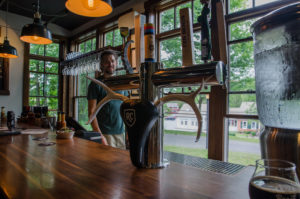
I finish a Heady Topper, and head across the street to Doc Ponds. The music is turned up, one of the 1,000 vinyl records from owner Eric Warnstedt’s collection and setting a beat for the evening. My order arrives quickly: it’s a burger, but not just any burger. Warnstedt is the chef who started Hen of the Wood in Burlington and Waterbury and, with business partner William McNeill, recently bought Prohibition Pig in Waterbury.
He’s also been on the cover of Food & Wine as one of the 10 up and coming chefs in the country and a finalist for the James Beard Award for “Best Chef, Northeast.” The burger, made with Vermont-raised beef and Vermont cheddar, is what one TripAdvisor reviewer called “the burger that changed my life.” And the beer? The menu is changing, but put it this way, Hill Farmstead is prominent and it’s almost all local, hard-to-find and curated by Tom Rowlett, one of seven certified cicerones (the beer equivalent of a master sommelier) in the state.
A few miles away, on the west side of town, a similar scene plays out. It’s no coincidence that some of the Nordic and mountain bike trails of the Trapp Family Lodge spill out at the resort’s Bierhall. An airy restaurant and bar, the Bierhall is attached to a brewery that now produces 2,000 barrels a year and serves Austrian dishes ranging from crispy Bavarian pretzels to an authentic chicken schnitzel.
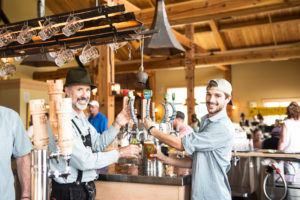
The Bierhall was the dream of Johannes von Trapp, the youngest son of Maria von Trapp and owner of the Trapp Family Lodge. But the mountain bike trails that lead to it are his kids’ passion. Just as their father laid out the ski trails that have made Trapp Family Lodge a winter destination, Sam and his sister Kristina (both top athletes who can ride, ski or run you to the ground), are now helping to shepherd the 2,500-acre family farm, outdoor center and guest lodge in new directions. The resort now has miles of mountain biking trails, one of the most beautiful disc golf courses in the state, running festivals and more.
“We used to promote the lodge,” says Sam. “Now we know if we talk about our mountain biking and our beer, our rooms fill up.”
Bikes, Beer and Transformations
In the past few years, bikes and beer have come to define Stowe as much as skis and snowboards, with the village-wide B3 block party (Bikes, Bevs and Beats) celebrating that pairing on June 14.
In recent years, the Stowe Mountain Bike Club, which formed in the

1990s, has morphed into the Stowe Trails Partnership and now has more than 1,000 members. The club helps to manage multi-use trails in four networks: 300 acres on Cady Hill, in the center of town; Sterling Forest, north of it; Adams Camp (which connects to the Trapp trails), and a new system that will connect Stowe with Waterbury’s trail system in Little River State Park, via trails off Cotton Brook road, near the northern access to Waterbury Reservoir.
Rick Sokoloff, one of the early presidents of the club, now runs Four Points, which teaches mountain biking at the Trapp Family Lodge Outdoor Center and offers guided tours to some of the dozen breweries and distilleries within a 10-mile radius of town, including four you could bike or walk between—von Trapp, The Alchemist, Idletyme, and Stowe Cider. “We’re getting people coming here now in all seasons just to taste beer,” says Sokoloff. “It’s like the Napa of New England.”
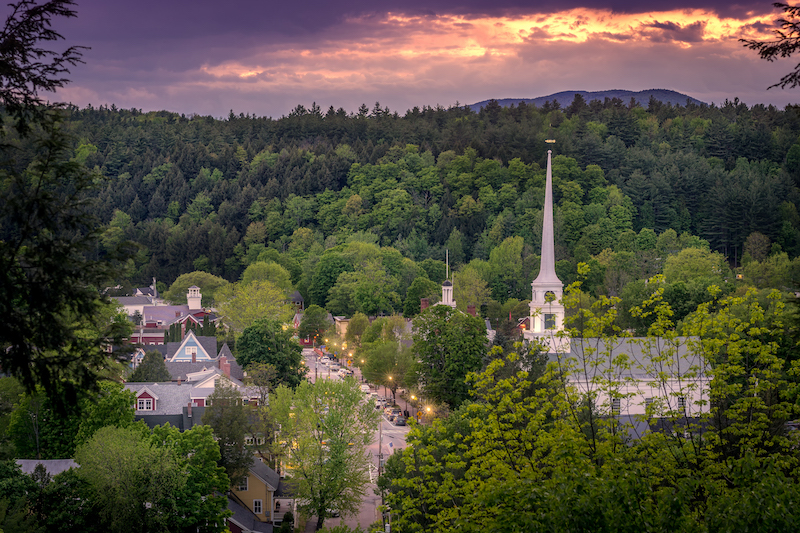
Stowe has, historically, been busier in the summer than in the winter, drawing crowds for craft fairs, the antique car show (no longer held there) and Vermont Symphony Orchestra performances in the Trapp Family Lodge concert meadow.
But things are changing. The busiest weekends of the year in this ski town are not July 4, President’s Day or winter holidays but the week in mid-July when the Bitter Lacrosse Tournament draws thousands of kids and their parents, according to Amy Spear, the former executive director of the Stowe Area Association.
EW Bitter, 36, who comes from a family of Div. 1 lacrosse players, started a lacrosse camp in Stowe in 2010. By 2011, more than 1,000 kids and parents were showing up for what became a week of tournaments. The success of that event prompted Bitter to buy the Town & Country motel and renovate it last year with a giant game room for kids.
Town & Country is just one of the motels that’s undergone a major renovation. “Five years ago, we were looking at all these aging inns that had maybe a dozen to 20 rooms and figuring that they would never sell and would need to be redeveloped as condos or affordable housing,” says Tom Jackman, Stowe’s town planner. “Now, we’re seeing a lot of them being bought up.” Edson Hill is now a stylish boutique hotel. Stowehof has been renovated. Timberholm, the Stowe Motel and Brass Lantern Inn all have seen recent overhauls, as has the Gray Fox Inn.
“When I was growing up here there were farms all along the Mountain Road and the Gray Fox Inn, which my parents ran, was an old farmhouse,” says Rachel Vandenberg, president of the Stowe Area Association.
The Next Generation
Rachel and Mark Vandenberg had been living in Holland before they moved back to Stowe in 2012 and took over the Sun & Ski motel, which Rachel’s parents also owned. “We wanted a better place to raise kids,” she says. “I love that I do the same things now with my children that we did as kids growing up here. On summer days, we ride our bikes on the Rec Path to a swimming hole in the West River and just hang out.” The couple renovated Sun & Ski as a hip, family-focused hotel with a stylish bowling alley, Stowe Bowl.

Rachel is just one of many next-generation Vermonters who have left, returned and are now revitalizing the town. As innkeepers, Sam and Kristina von Trapp maintain the level of gracious hospitality their grandmother, Maria von Trapp, brought to Vermont from Austria. Five generations of Baraws have run Stoweflake Resort and Spa. When Howard Shaw started Shaw’s General Store on Main Street in 1895, he could not have dreamed that his great-great granddaughter. Anne Marie Vespa and her husband Sal, would now operate it.
McKee Macdonald and his sister, Maggie both moved back to Stowe after working in New York and joined their mother’s real estate business as the Smith Macdonald Group (part of Coldwell Banker Carlson Real Estate).
The Macdonalds, both in their early 40s, tick off names of the people they grew up with who now own businesses in the village: Former pro hockey player Graham Mink returned to the town he grew up in and he and his wife reinvented the old Main Street classic, Lackeys’ Variety Store, as a more upscale home decor and kitchen shop, The Country Store. Andrew Neale came back to Stowe in 2003 to help his mother run Harrison’s restaurant and bar. Danielle Nichols Moffatt and her sisters, Morgan and Katie Nichols, opened the wine bar Cork in the village.
“When I came back here 10 years ago after working in real estate in New York City, it was for the lifestyle – to be able to mountain bike and raise kids here. What I found was that it was also great to reconnect with all my old friends I grew up with,” says McKee.
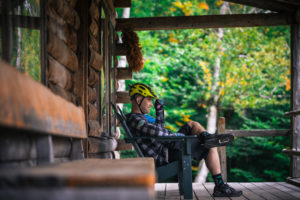
“I think the thing that draws us back is the same thing that amazes people who move here: it’s how this community sticks together and supports each other,” adds Maggie.
The Once and Future Stowe
In many ways, Stowe hasn’t change much from the town the Macdonalds grew up in. There are still four working dairy farms, owned by the fourth or fifth generations of Percys or Pikes, and a half-dozen other farms. There are also relatively new farmers in town, such as sisters Mollie and Katie Pindell whose Sage Farm produces goat milk cheeses; or Annie and Andrew Paradee who have an honor-system farmstand for produce at their Long Winter Farm.
Of the 77 miles of town roads that crisscross Stowe, 65 miles are dirt—Class Three or Four roads. The town still has no stoplight. And one of the largest undeveloped parcels in the area, 750 acres of Brownsville Forest, is being preserved thanks in part to an anonymous $5 million donation in 2019 to the Stowe Land Trust.
Two town ordinances–one limiting retail to under 5,000 sq. ft. and another banning
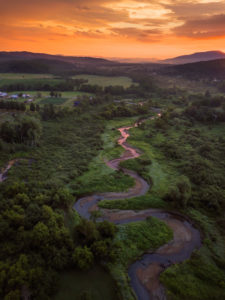
drive-throughs–have effectively kept out box stores and franchises. In the 1990s, a McDonalds operated out of the building that now houses Sushi Yoshi. The McDonalds went out of business.
This summer, the village power lines are being buried, as part of a sidewalk project. Condos and hostels are mushrooming along the Mountain Road. The lot at the Alchemist Brewery, shaded by solar panels, is often packed as people vie for parking, then stand in line to buy their famed Heady Topper. Last fall, Stowe Cider opened a new tasting room across from the venerable Rusty Nail.
The “Nail” turns 50 this year and new owners Chad Fry and Mark Frier are reviving
the legendary music and night spot. “I’ve been following what’s happened with the Alchemist since they were based in Waterbury and I started The Reservoir right next door ten years ago,” says Frier, a former engineer from Chicago who originally moved to Vermont to get a job at Burton “because they have a dog policy and I couldn’t imagine anything cooler than that.” Frier followed The Alchemist to Stowe and when it opened a second brewery he bought first The Bench, a restaurant, and then, last year, The Rusty Nail.
That “follow success” approach has also attracted larger out-of-state companies. Last winter, Topnotch Resort and Spa, a Stowe icon since the 1950s, was bought by the real estate investment firm AWH Partners and its hotel management arm Spire Hospitality. “With Vail Resorts now running the Stowe Mountain skiing operations and bringing both the Epic Pass and Vail’s vast resources to the destination, we see great potential,” said Chad Cooley, the 40-year-old principal of AWH Partners, when the purchase was announced in January.
It Takes A(nother) Village
Long before Vail Resorts started looking to buy Stowe’s ski area, Sam Gaines was figuring out what to do with the Spruce Peak side of Stowe Mountain Resort. In 2011, Gaines and his wife, Molly, a former features editor at Cosmopolitan, moved to Stowe from Brooklyn for his job with AIG, which owned Stowe Mountain Resort at the time. “It was right after the financial collapse and we were not really sure what Spruce Peak was going to become,” says Gaines, who had first come to Stowe to ski when he was four years old.
“I think after the financial crisis people’s values changed. It was no longer about building the golf course resort for baby boomers who were looking to retire or parents packing their kids off to camp all summer. Suddenly, we were seeing more people in their 30s and 40s who wanted to vacation with and spend time with their kids.”
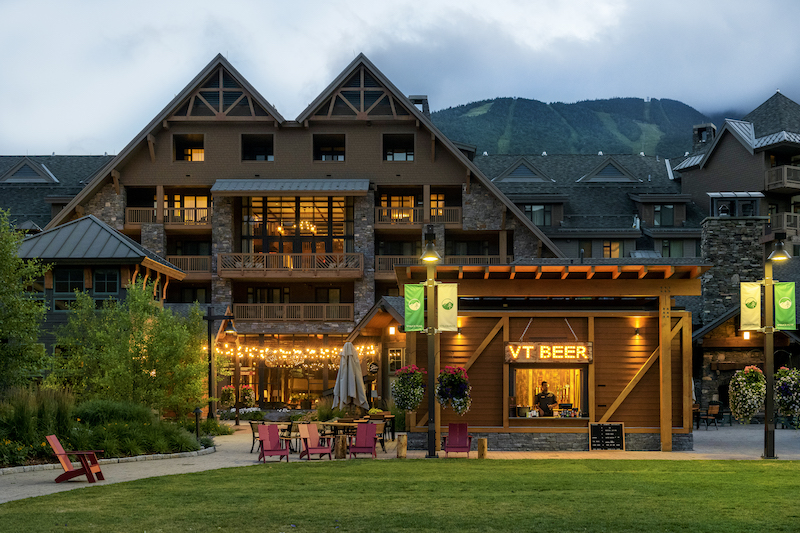
In response, Spruce Peak, which already had a golf course, began to build out as a second-home community with a posh Alpine Club, a kids’ adventure center, a green where farmers markets and family-style outdoor farm dinners are held. This summer for the second year, there’s a folk festival planned. Gradually, what was once mainly a winter ski resort has become a year-round weekenders’ village. In 2016, Spruce Peak sold $70 million in units.
When AIG sold the ski operations, lifts and zipline of Stowe Mountain Resort to Vail Resorts in 2017, the real estate division kept the hotel and most of the new development on the Spruce Peak side of the resort. “We realized we had a marketing powerhouse next door and that Stowe was only going to get busier,” says Gaines, who at 38 is now president of Spruce Peak and a managing director of AIG Global Real Estate.
Over the last year, Gaines and his team have rebranded the AIG-owned side of the resort, as “Spruce Peak at Stowe” and announced the construction of a new 12-story building, One Spruce Peak, that will house 27 high-end units.
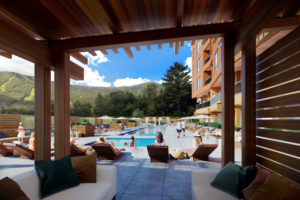
That growth has not been without the occasional conflict, conflict that ski towns across America face. Many workers can no longer afford to live in Stowe. For several years, Stowe Mountain Resort has housed employees at what was once the Inn at the Mountain, and recently contracted with a new hostel going up on the Mountain Road.
According to town planner Tom Jackman, 60 percent of Stowe’s single-family homes and 85 percent of condo units are second homes. As Maggie Macdonald also notes, “And a lot of the places that used to be available for long term rentals are now short-term Airbnb rentals.”
As larger operations, such as Stowe Mountain Resort and Spruce Peak, have been buying or renting units up and down the Mountain Road for their staff, affordable rentals have gotten even harder to find.
And then there are the complaints about parking and traffic, which grew to a crescendo on powder days this past winter
“People complain about the parking thing, but the times we had parking problems last season weren’t the 9,000-skier days over the holidays when families shared one car but the 5,000-skier powder days when every local from Burlington drove up in a single car,” says Gaines.
“The solution isn’t to build more parking. It costs $50,000 per parking space to build a garage and you can’t even get financing for a garage anymore because banks don’t believe they will be used in 10 years. The solution is to get people out of cars and onto public transportation.”
Still, Gaines recognizes that one of the hallmarks of both the town of Stowe (which has a year-round population of 5,000) and Spruce Peak (which has 500 units) is that these are both relatively small.
“That scale means we can build a real community and have it mean something,” says Gaines. “We don’t have room up here at the mountain for a lot more people. One of the beauties of Stowe is we are limited in size. The ski mountain itself, with its current lifts can only handle about 9,000 people a day. I don’t see Stowe getting much bigger,” he says.
Across Route 100, the lifts of Stowe Mountain Resort are quiet, for now. The gondola starts running on June 22, taking people up to one of the longest zip lines in the East
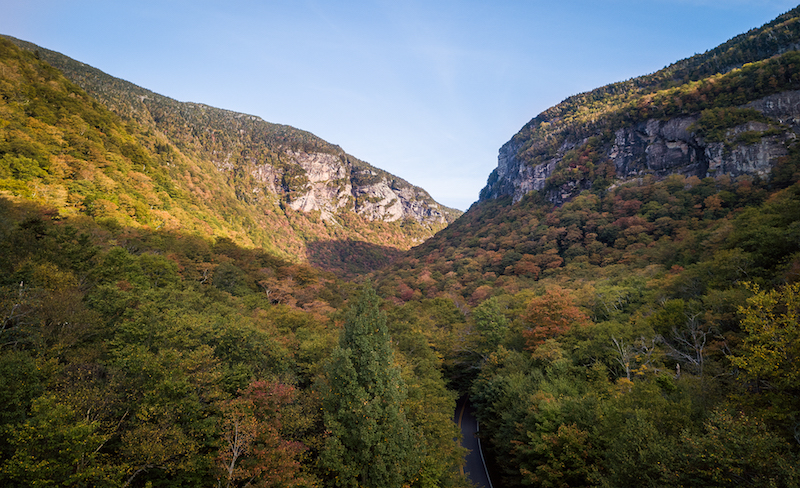
and for meals at the Cliff House restaurant. A tree-top ropes course set up near the Mt. Mansfield base lodge has enough challenge and variations to keep adults and kids entertained for several hours. Up Route 108, hikers set off on the Long Trail and rock climbers, laden with ropes, to scale the cliffs and boulders in Smuggler’s Notch.
Since purchasing the Stowe Mountain Resort in 2017, Vail Resorts has been conservative in investing in summer. “There is an old plan for mountain biking trails off triple,” general manager Bobby Murphy, himself an avid cyclist, admits. “But we’re waiting to see if more mountain bike trails are a good investment, especially when there’s such a good cross-country network in town.”
In the meantime, summer’s “base lodges” – the places where people gather after biking or hiking are the Bierhalls, Ranch Camps, Doc Ponds, Matterhorns and other watering holes around town.
There, after bike rides and over beers, the “new Stowe” is evolving out of what Stowe has always been: a village community.
Featured Photo Caption: A mountain biker takes to the trails. Photo by Mike Hitelman

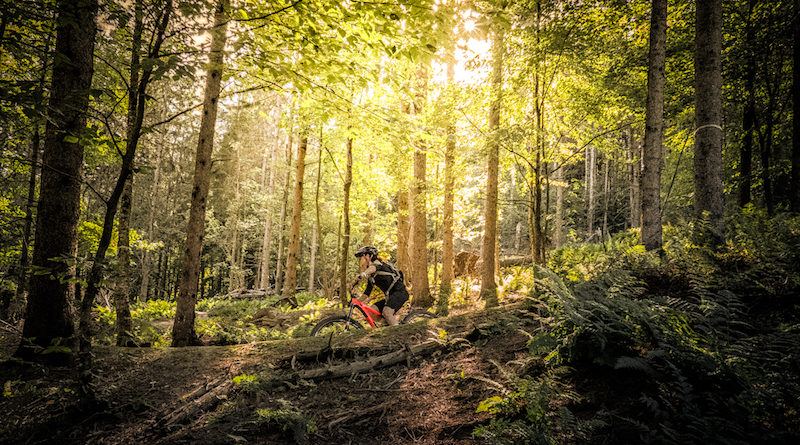
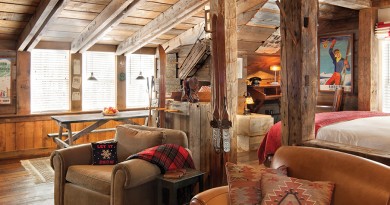
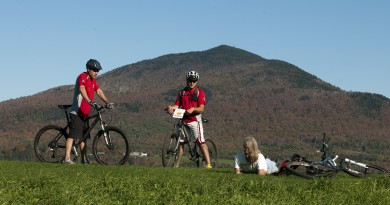
Pingback: Read the Summer Issue! – VT SKI + RIDE